Top 10 Employee Engagement Strategies That Actually Work in 2025
Discover 10 powerful employee engagement strategies to boost motivation, productivity, and workplace satisfaction in 2025. Build a thriving team today!
Employee engagement is the heartbeat of a thriving workplace and plays an important role in resource management. It boosts productivity, fuels creativity, and builds a culture where employees feel valued and motivated. In 2025, with hybrid work models, advancing technology, and evolving employee expectations, businesses need practical, impactful strategies to keep teams connected and driven. This blog explores ten proven employee engagement strategies to empower your workforce while also helps you understand the role of leadership in this.
Why Employee Engagement Matters in 2025
Engagement drives business success. According to Gallup’s article, engaged teams can increase productivity by 23% and reduce turnover by up to 43%. In a competitive talent market, retaining top performers and fostering a positive culture are essential. Engagement isn’t about superficial perks like free snacks; it’s about creating trust, offering growth, and using resources effectively. In 2025, with remote and hybrid work standard, businesses must prioritize engagement to stay ahead.
Engagement also impacts innovation and customer satisfaction. Employees who feel connected to their work are more likely to contribute ideas and deliver exceptional results. This blog provides a roadmap to boost engagement, with strategies and insights tailored for modern workplaces.
Explaining Resource Management
Resource management is the foundation of effective engagement. It involves allocating time, budget, and tools to maximize employee potential while aligning with company goals. When done right, it ensures employees have what they need to succeed without feeling overwhelmed.
- Core components: Balancing workloads, matching tasks to skills, and planning capacity. Project management tools help managers track project demands, assign tasks efficiently, and prevent burnout.
- Why it’s critical: Smart resource management shows employees their time and skills are valued, boosting morale and productivity.
For a deeper dive, check out our full blog on Explain Resource Management
Action Tip: Use resource management software to monitor workloads and adjust assignments in real time.
10 Employee Engagement Strategies for 2025
These ten strategies are designed to foster connection, growth, and well-being, all supported by effective resource management.
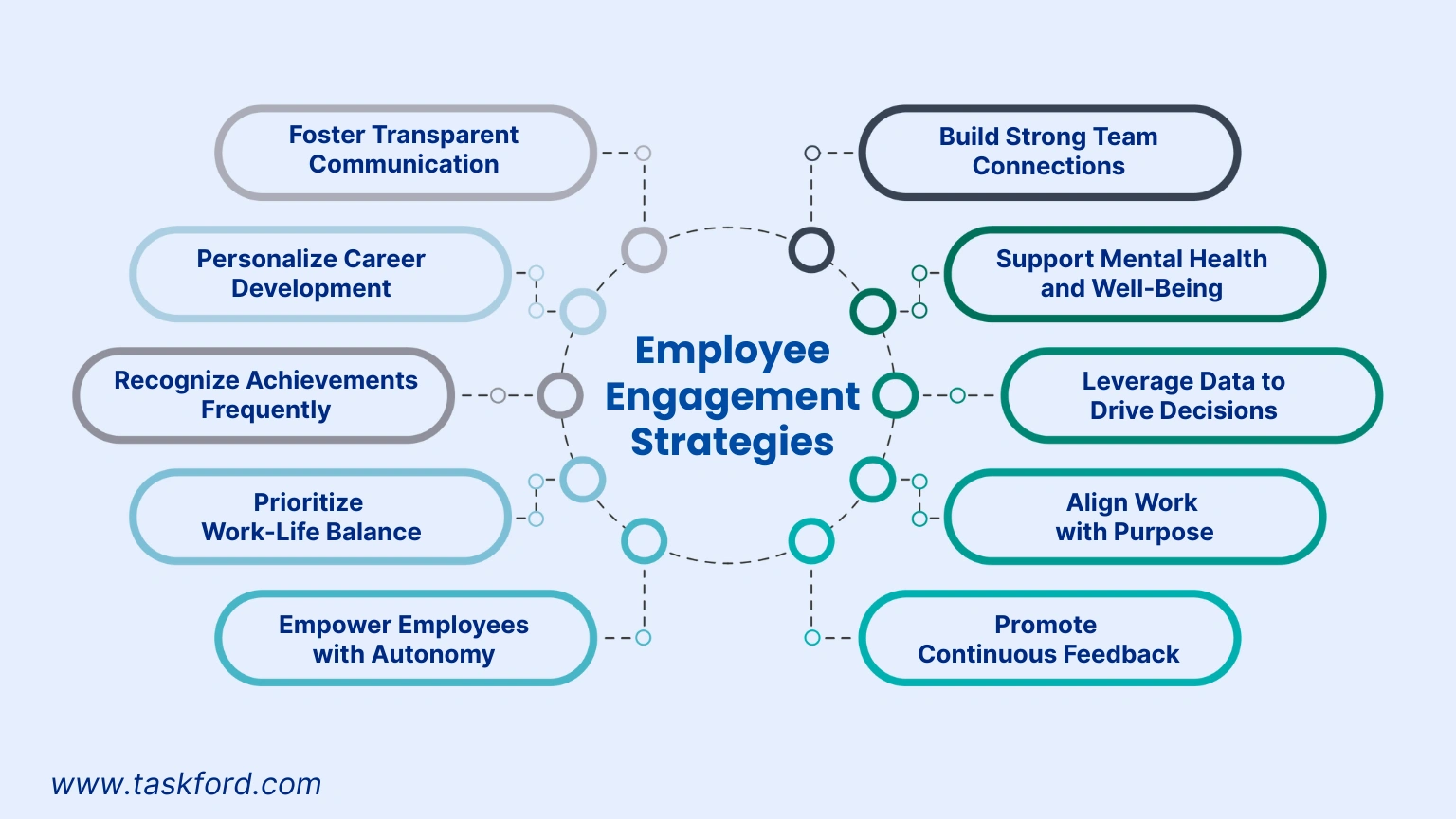
1. Foster Transparent Communication
In 2025, employees value authenticity over polished messaging. Sharing successes and setbacks such as a delayed product launch builds trust, especially in hybrid teams where vague updates breed disconnection. Employees crave clarity on company goals, challenges, and their role.
- How to do it: Use Slack or Microsoft Teams for real-time updates. Host virtual town halls with Q&A sessions or deploy anonymous feedback tools like SurveyMonkey. A biweekly “Leadership Spotlight” can humanize executives, sharing their vision and challenges.
- Why it works: Transparency creates a culture of inclusion, reducing uncertainty and aligning teams with shared goals.
Action Tip: Set up a feedback portal where employees share ideas, with leaders responding within 48 hours.
2. Personalize Career Development
Employees want growth plans tailored to their aspirations, not generic training that feels like a checkbox. In 2025, “learn-as-you-go” opportunities resonate, like offering a junior developer a coding bootcamp over a broad leadership course to directly enhance their role.
- How to do it: Use TaskFord to analyze skills and match employees with relevant training. Offer micro-learning modules, mentorship pairings, or subscriptions to platforms like LinkedIn Learning.
- Why it works: Personalized development shows investment in employees’ futures, boosting loyalty.
Action Tip: Hold quarterly career check-ins to refine development plans and allocate training budgets.
3. Recognize Achievements with Impact
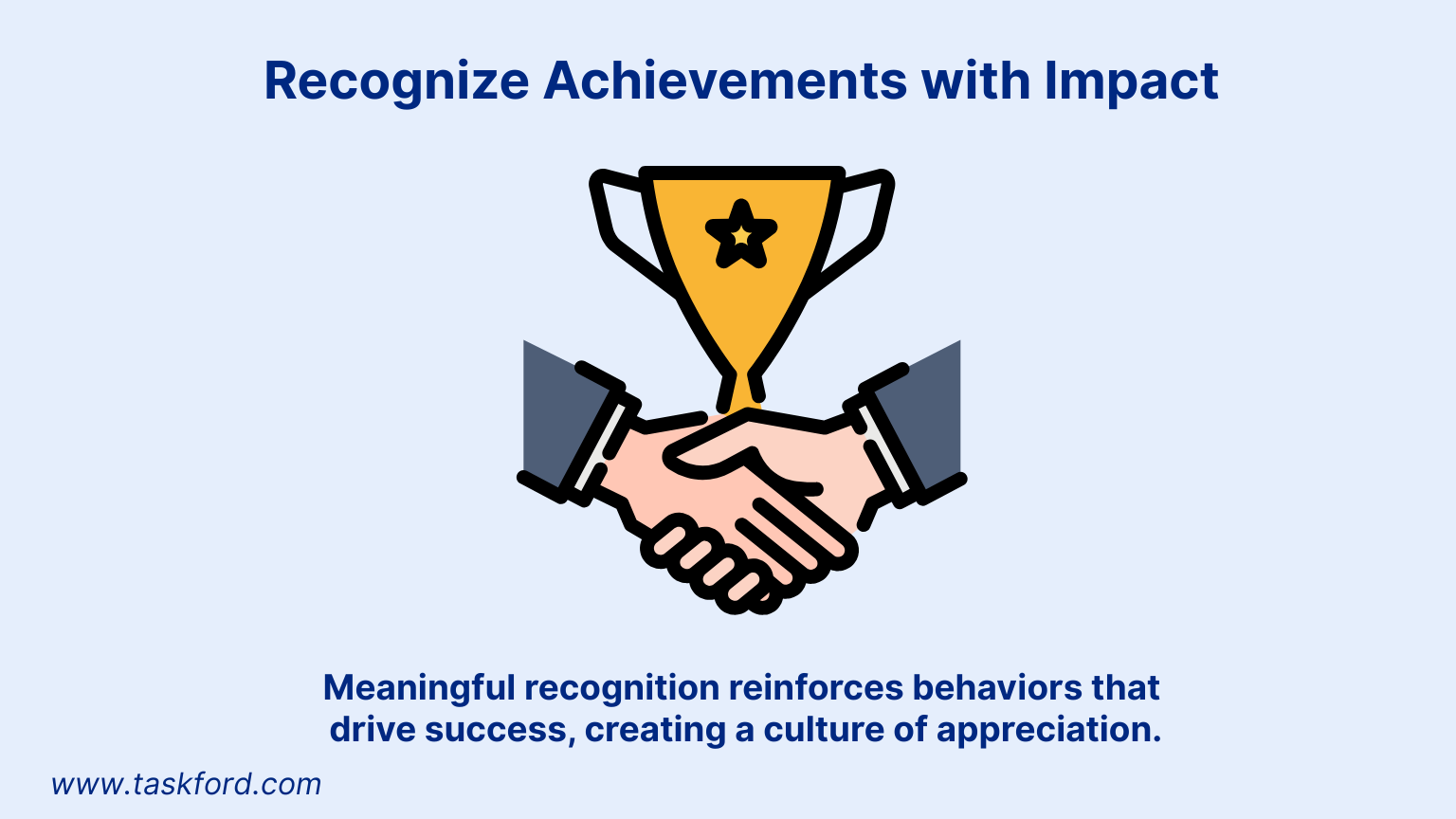
Recognition is a catalyst for motivation, especially when it’s public and specific. In 2025, a shout-out in a company-wide newsletter or virtual event amplifies impact and inspires others, far surpassing a private email. Employees who feel valued are nearly three times more likely to be engaged.
- How to do it: Implement peer-to-peer recognition. Highlight specific contributions, like a designer’s innovative UI or a salesperson’s client win, in team meetings.
- Why it works: Meaningful recognition reinforces behaviors that drive success, creating a culture of appreciation.
Action Tip: Budget for tangible rewards, like gift cards or extra time off, in your resource management plan.
4. Prioritize Work-Life Balance
Flexibility is non-negotiable, with employees valuing outcome-based control over their schedules. In 2025, allowing a parent to adjust hours for school pickups while meeting deadlines shows trust and boosts morale, especially in remote or hybrid settings.
-
How to do it: Use TaskFord to balance workloads and avoid burnout. Set clear availability guidelines for hybrid teams to prevent overreach.
(Learn more: How To Reduce Burnout On A Project)
-
Why it works: Flexibility reduces stress, allowing employees to perform at their best.
Action Tip: Test a four-day workweek for select teams and track engagement over three months.
5. Empower Employees with Autonomy
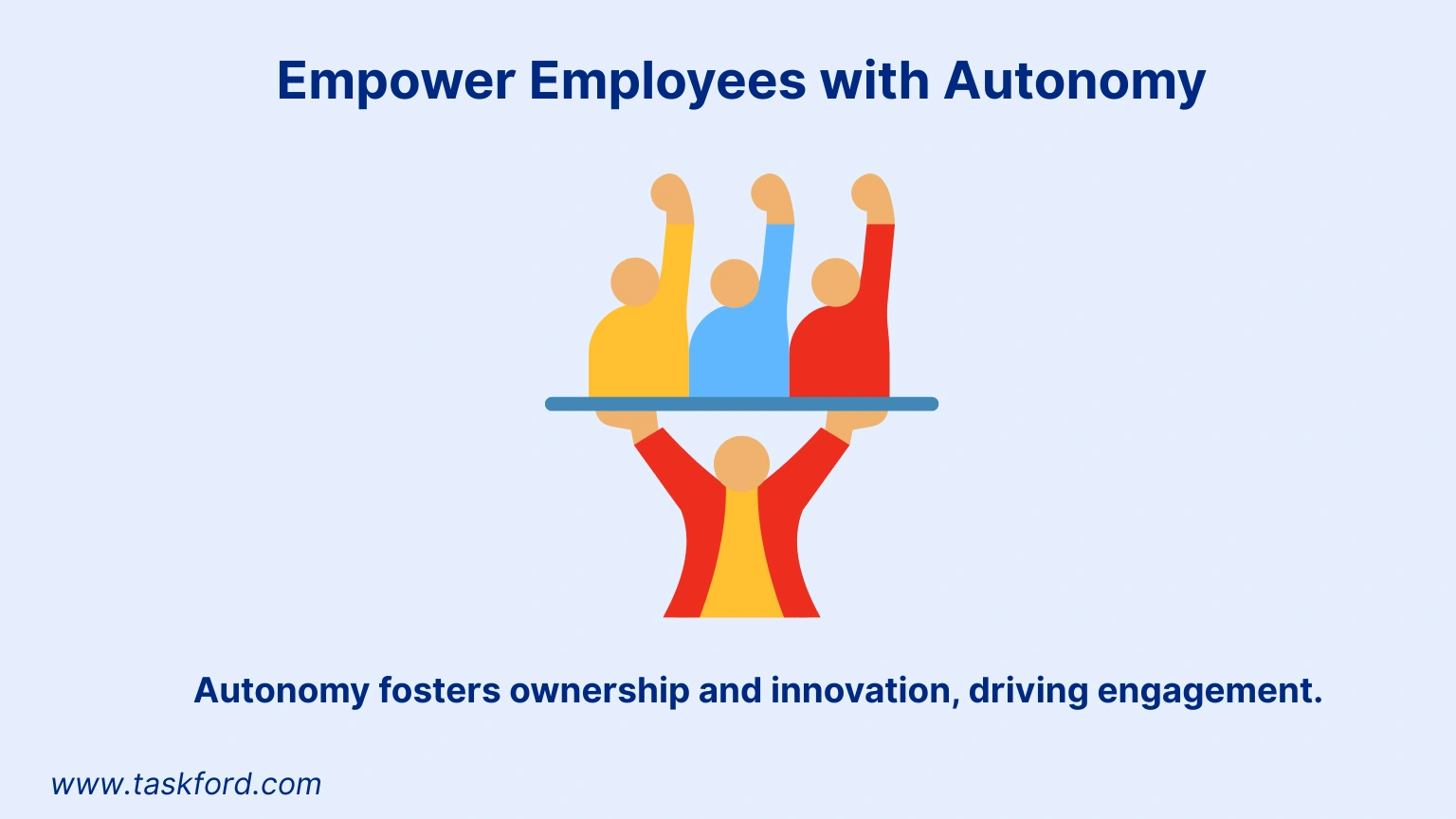
Micromanagement crushes motivation, but autonomy sparks creativity, especially in creative or knowledge-based roles. In 2025, autonomy means trust, not abandonment. Regular check-ins with questions like “What’s working for you?” provide support without stifling freedom.
- How to do it: Define clear goals and let employees choose their methods. For instance, allow a content team to experiment with new formats while meeting campaign targets. Project management tools help track progress without intrusive oversight.
- Why it works: Autonomy fosters ownership and innovation, driving engagement.
Action Tip: Train managers to focus on outcomes, not processes, during check-ins.
6. Build Strong Team Connections
A sense of belonging is a cornerstone of engagement, and hybrid teams crave authentic connection in 2025. A “virtual coffee break” where employees share personal updates can be as impactful as a formal team-building event, combating isolation in remote settings.
- How to do it: Host virtual trivia nights or in-person offsites. Use a resource management tool to budget events equitably across departments. Assign cross-functional projects to spark collaboration.
- Why it works: Strong relationships enhance teamwork and morale, reducing turnover.
Action Tip: Create a monthly “connection calendar” with virtual and in-person activities.
7. Support Mental Health and Well-Being
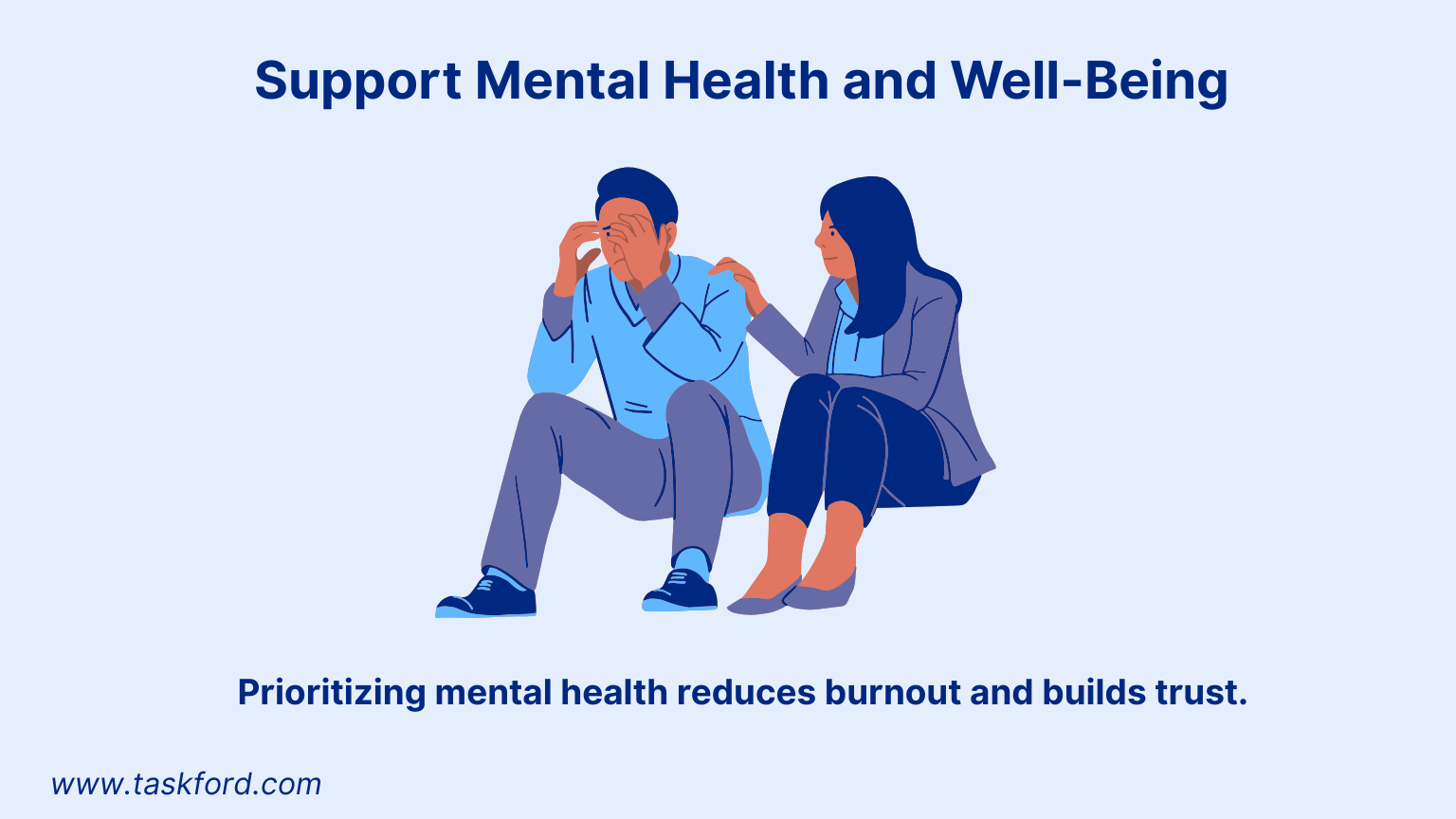
Mental health is a top priority in 2025, with employees seeking workplaces that proactively address modern stressors, like Zoom fatigue. Offering “no-meeting” days shows you understand their needs and care about their well-being.
- How to do it: Provide access to counseling, mental health days. Use TaskFord to allocate budgets for well-being programs. Train managers to recognize stress signals.
- Why it works: Prioritizing mental health reduces burnout and builds trust.
Action Tip: Promote wellness resources in team meetings and track participation to gauge impact.
8. Leverage Data to Drive Decisions
Data is a game-changer for engagement, but in 2025, employees expect action, not just surveys. Sharing how feedback led to changes builds credibility and shows their input matters.
- How to do it: Monitor resource use and spot overworked teams. Run pulse surveys monthly to capture real-time sentiment and act swiftly.
- Why it works: Data-driven decisions pinpoint issues, ensuring resources are used effectively.
Action Tip: Set up a dashboard to track engagement metrics and review monthly.
9. Align Work with Purpose
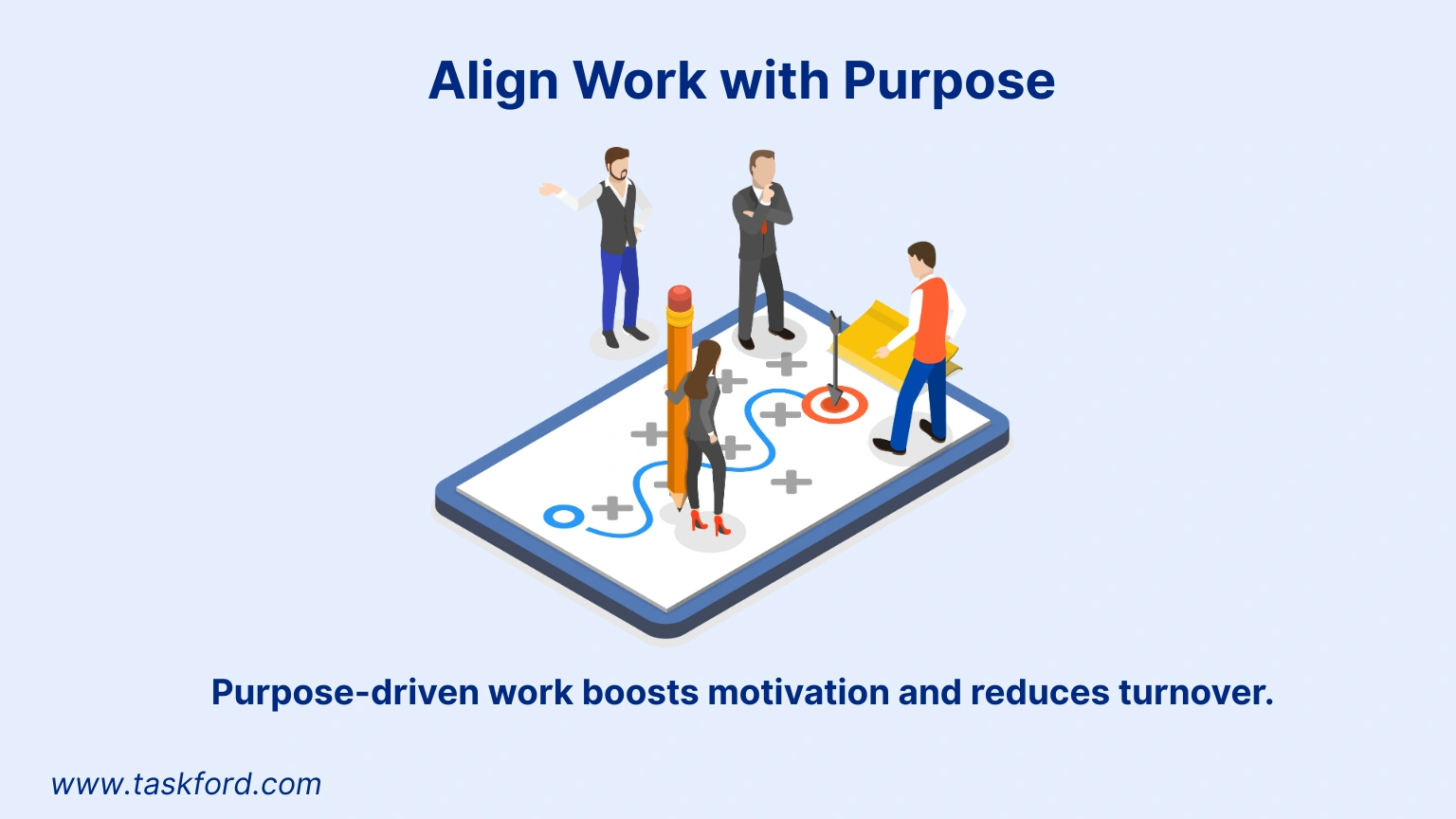
Employees want work that feels meaningful, and in 2025, purpose is personal. Asking “What makes your work meaningful?” during one-on-ones can uncover unique motivators, like contributing to sustainability goals, igniting passion and commitment.
- How to do it: Show how tasks impact goals. For example, link a customer service team’s efforts to improved client satisfaction. Use a task management platform to align assignments with strategic priorities.
- Why it works: Purpose-driven work boosts motivation and reduces turnover.
Action Tip: Include mission-focused discussions in onboarding and team meetings.
10. Promote Continuous Feedback
Annual reviews feel outdated in 2025’s fast-paced world. Employees want ongoing feedback, with managers who listen and act on their input like adjusting a project based on team suggestions to feel heard and valued.
- How to do it: Conduct weekly check-ins with the teams. Train managers to give constructive, timely feedback and ask open-ended questions.
- Why it works: Continuous feedback creates a culture of growth and responsiveness.
Action Tip: Train managers on effective feedback techniques and schedule biweekly check-ins.
Overcoming Engagement Challenges
Implementing these strategies can face hurdles like budget constraints, resistance to change, or remote work dynamics. Here’s how to address them:
- Start small: Pilot one strategy, like recognition, and measure results before scaling.
- Communicate clearly: Explain the purpose of changes to gain buy-in from employees and leadership.
- Use resources wisely: An advanced project management and resource planning platform like TaskFord can help manage funds and allocate time efficiently for sustainable efforts.
Action Tip: Host a workshop to align leadership on engagement goals and resource needs.
Employee Engagement Trends Shaping 2025
Several trends are reshaping employee engagement in 2025, driven by evolving workplace dynamics and employee priorities. Understanding these trends helps businesses tailor strategies to meet modern needs.
- Hybrid work dominance: Most employees expect flexible arrangements, blending remote and in-person work. Companies must balance collaboration and autonomy to maintain engagement across settings.
- Mental health priority: Workers increasingly seek workplaces that support emotional well-being, with access to resources like counseling or stress management programs.
- Purpose-driven roles: Employees want work that aligns with personal values and company missions, seeking roles that feel meaningful and impactful.
- Diversity and inclusion focus: Employees value inclusive workplaces that celebrate diverse perspectives, fostering a sense of belonging and fairness.
- Upskilling demand: With rapid technological changes, employees prioritize continuous learning to stay relevant, expecting employers to provide accessible training.
- Employee voice amplification: Workers want platforms to share ideas and feedback, driving demand for transparent communication and responsive leadership.
- Sustainability and social impact: Employees are drawn to companies with strong environmental and social responsibility, linking engagement to broader societal goals.
Measuring Employee Engagement Strategies Success
To ensure these strategies work, track key performance indicators (KPIs):
- Employee satisfaction scores
- Retention rates
- Productivity metrics
- Training participation
- Absenteeism rates
Data analytics tools help monitor resource use and engagement trends. For example, if flexible scheduling reduces absenteeism, that’s a clear win. Review data monthly to keep strategies aligned with employee and business needs.
Action Tip: Use pulse surveys to gather real-time feedback and adjust strategies as needed.
How Team Leaders Can Help With Employee Engagement Strategies
Leaders shape workplace culture. Their actions and priorities influence how employees feel valued and engaged. In 2025, effective leadership is vital, especially in hybrid and remote settings where personal connections can feel distant.
Leading by Example
Engaged leaders inspire engaged teams. When leaders show empathy, transparency, and commitment, they set a positive tone. For example, a manager who shares company updates and acknowledges team efforts fosters trust. Disconnected leaders, however, can erode morale, even with strong engagement strategies in place.
Equipping Leaders for Success
Leaders need tools and training to drive engagement. Here are key ways to support them:
- Provide training: Offer workshops on communication, emotional intelligence, and resource management.
- Use resource management tools: Help leaders have effective resource allocation to support teams without overwhelming them.
- Encourage regular check-ins: Ensure leaders prioritize employee well-being, not just performance.
Building Trust Through Action
Leaders should act on employee feedback to show they care. A leader who asks, “What support do you need?” and follows through builds loyalty. Celebrate small wins, like meeting a deadline, to boost morale. If a project’s timeline is tight, leaders can reallocate resources, easing team pressure. These actions create a ripple effect, enhancing engagement across the organization.
Conclusion: Build a Thriving Workplace in 2025
Employee engagement in 2025 is about creating a workplace where people feel valued, connected, and empowered. These ten strategies provide a clear path forward. Supported by effective resource management and planning tools like TaskFord, they ensure your workforce thrives.
Learn more
- The 4 Functions of Management: What Managers Need to Know
- 7 Essential Human Resources Skills Every Professional Needs to Excel
- Top Resource Planning Software for Hybrid Teams in 2025: A Feature-by-Feature Comparison
Subscribe for Expert Tips
Unlock expert insights and stay ahead with TaskFord. Sign up now to receive valuable tips, strategies, and updates directly in your inbox.